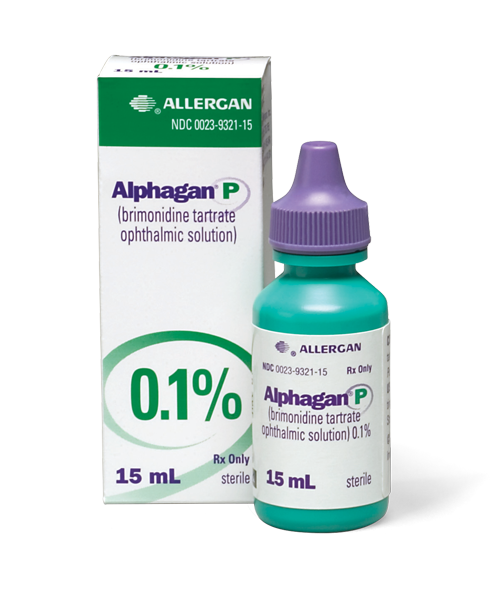Make sure you get the green bottle

FREQUENTLY ASKED
QUESTIONS (FAQs)
What is glaucoma?
Glaucoma is a disease that damages the eye’s optic nerve, often caused by extra fluid that increases pressure in the eye.
Open-angle glaucoma is the most common form of glaucoma. It develops gradually and often goes unnoticed at first. Regular eye exams are important to find early signs of damage to the optic nerve.
Is there a cure for glaucoma?
While there is no cure for glaucoma, studies show that lowering high eye pressure can help reduce the risk of glaucoma-related vision loss. That's why daily treatment of high eye pressure is very important. Remember, high eye pressure can slowly, but permanently, damage your optic nerve before you notice any change in vision.
What can I do to manage my glaucoma or high eye pressure?
Your doctor can recommend a prescription eye drop to help you manage your glaucoma or high eye pressure. One option is ALPHAGAN® P 0.1%.
What is ALPHAGAN® P 0.1%?
ALPHAGAN® P 0.1% ophthalmic solution is an FDA-approved eye medication used to lower high eye pressure in patients with open-angle glaucoma or ocular hypertension (high eye pressure). If your doctor prescribes ALPHAGAN® P 0.1%, check to make sure you get the green bottle that is labeled "Alphagan® P 0.1%" at the pharmacy.
Why did my doctor choose ALPHAGAN® P 0.1%?
Prescription eye drops are commonly used to reduce high eye pressure. ALPHAGAN® P 0.1% is a FDA-approved medication proven to lower high eye pressure in patients with open-angle glaucoma or ocular hypertension (high eye pressure).
How do I use ALPHAGAN® P 0.1%?
The recommended dose of ALPHAGAN® P 0.1% is 1 drop in the affected eye(s) 3 times a day, about 8 hours apart. If you use more than 1 type of topical eye drop, just be sure to apply them at least 5 minutes apart.
If you have open-angle glaucoma or ocular hypertension (high eye pressure), it is important to continue your ALPHAGAN® P 0.1% therapy. Don’t skip or stop treatment (unless you have spoken to your doctor). Remembering to use your eye drops is easier if you make it part of your daily routine.
If you wear contact lenses, remove them first, then wait 15 minutes after using ALPHAGAN® P 0.1% before you put them back into your eyes.
What are the most common side effects of ALPHAGAN® P 0.1%?
In a 3-month long study, the most common side effects of ALPHAGAN® P 0.1% were eye allergies (allergic conjunctivitis), eye redness (hyperemia), and itchy eyes (eye pruritus). If you develop these or other side effects, contact your eye doctor immediately. 10% to 20% of patients (n=215) experienced allergic conjunctivitis, conjunctival hyperemia, and eye pruritus. 5% to 9% of patients (n=215) experienced burning sensation, conjunctival folliculosis, hypertension, ocular allergic reaction, oral dryness, and visual disturbance.
How can I save on my ALPHAGAN® P 0.1% prescription?
Eligible commercially-insured patients may pay as little as <$30*> per 90-day prescription fill. To access savings on your ALPHAGAN® P 0.1% prescription, enroll online here. You can also enroll for discounts by calling 1-833-Dial-AYS (1-833-342-5297), or texting SAVINGS to 72428.†
*Maximum savings limits apply; patient out-of-pocket expense will vary depending on insurance coverage. Offer valid for patients with commercial prescription insurance coverage and a valid prescription for LUMIGAN® 0.01%, COMBIGAN®, or ALPHAGAN® P 0.1%. Offer not valid for patients enrolled in Medicare, Medicaid, or any other federal, state, or government-funded healthcare program. See At Your Service Savings Program Terms, Conditions, and Eligibility Criteria at SaveWithAYS.com.
†AYS Alerts: Msg and data rates apply. Msg frequency depends on user. Reply HELP for help; reply STOP to cancel. Consent to texts not required to sign up for offer. View our Mobile Terms & Conditions and Privacy Policy.
USE
ALPHAGAN® P (brimonidine tartrate ophthalmic solution) 0.1% or 0.15% is used for the reduction of high eye pressure, also called intraocular pressure (IOP), in patients with open-angle glaucoma or ocular hypertension.
IMPORTANT SAFETY INFORMATION
Do not use ALPHAGAN® P 0.1% and 0.15%:
- If you are allergic to any of the ingredients
- In neonates and infants (under the age of 2 years)
ALPHAGAN® P 0.1% and 0.15% may make syndromes associated with vascular insufficiency (conditions that result in reduced blood flow) worse.
ALPHAGAN® P 0.1% and 0.15% should be used with caution in patients with:
- Depression
- Cerebral or coronary insufficiency (conditions that result in reduced blood supply to the brain or heart)
- Raynaud’s phenomenon (a condition that results in reduced blood supply, most commonly, to the fingers and toes)
- Orthostatic hypotension (a form of low blood pressure that occurs when standing after sitting or lying down)
- Thromboangiitis obliterans (Buerger’s disease) (a condition that results in reduced blood supply to the arms and legs, usually presenting in fingers and feet)
- Severe cardiovascular disease (a range of conditions affecting the heart)
Avoid allowing the tip of the dispensing bottle to touch the eye, anything around the eye, fingers, or any other surface to avoid contamination by common bacteria known to cause eye infections (bacterial keratitis). Using contaminated solutions can cause serious damage to the eye and loss of vision. Always replace the cap after using. Do not use after the expiration date marked on the bottle or if the solution changes color or becomes cloudy.
If you have eye surgery, eye trauma or infection, or develop any eye reactions, immediately consult with your physician about continuing the use of ALPHAGAN® P 0.1% and 0.15%.
If you use more than one drug in the eye, be sure to wait at least 5 minutes between each drug application.
As with other similar medications, ALPHAGAN® P 0.1% and 0.15% may cause fatigue and/or drowsiness in some patients. Patients who engage in hazardous activities should be aware of the potential for a decrease in mental alertness.
The most common side effects (10%-20%) in the clinical trial include allergic eye reaction, eye redness, and itchy eye. Other side effects (5%-9%) include eye burning sensation, inflammation of the conjunctiva (“pink eye”), high blood pressure, dry mouth, and visual disturbance. These are not all of the possible side effects with ALPHAGAN® P 0.1% and 0.15%. Tell your doctor if you have any side effect that bothers you or that does not go away.
Please see full Prescribing Information for ALPHAGAN® P at https://www.rxabbvie.com/pdf/
alphagan_pi.pdf.
You are encouraged to report negative side effects of prescription drugs to the FDA.
Visit www.fda.gov/medwatch or call
1-800-FDA-1088.
If you are having difficulty paying for your medicine, AbbVie may be able to help. Visit AbbVie.com/myAbbVieAssist to learn more.



